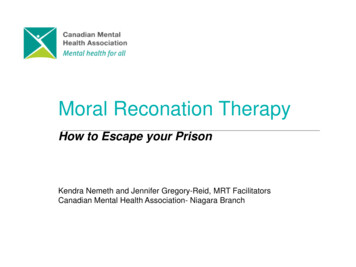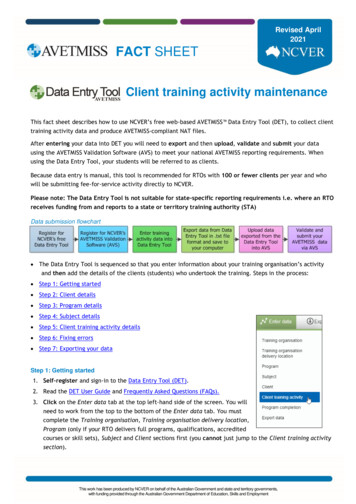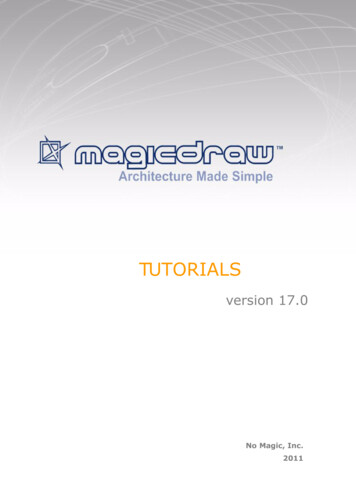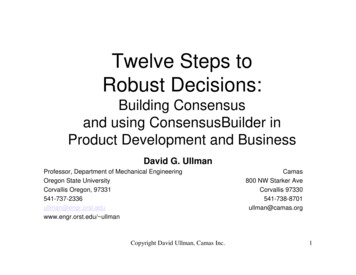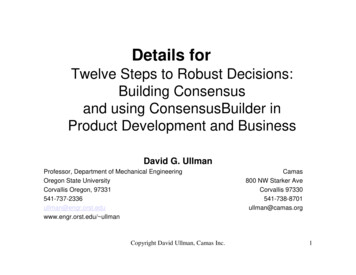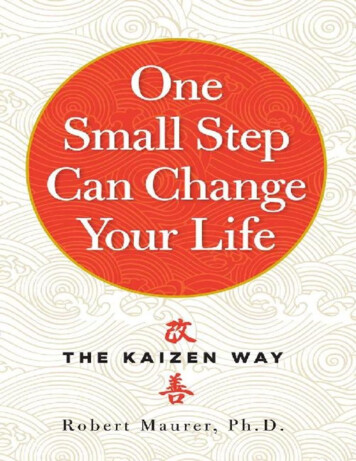
Transcription
One Small Step Can Change Your Life
THE KAIZEN WAYROBERT MAURER, PH.D.WORKMAN PUBLISHING NEW YORK
for Mort Maurer, my father, who helped me to see the power of kaizen in the workplace, and mymother, Miriam, who demonstrated the strength of kaizen in relationships
CONTENTSPrefaceIntroductionChapter One: Why Kaizen WorksChapter Two: Ask Small QuestionsChapter Three: Think Small ThoughtsChapter Four: Take Small ActionsChapter Five: Solve Small ProblemsChapter Six: Bestow Small RewardsChapter Seven: Identify Small MomentsChapter Eight: Kaizen for LifeAcknowledgmentsAbout the Author
PREFACE“Small things with great love. . . . It is not how much we do, but how much love we put into thedoing. And it is not how much we give, but how much love we put into the giving. To God there isnothing small.”—Mother Teresa“Change is hard!”It’s a sentiment so widely accepted as fact that we don’t question whether or not it’s actually true. Andthere are good reasons why many of us see change as a mountain to climb. Consider New Year’sresolutions, which almost always fail. The average American makes the same resolution ten years in arow without success. Within four months, 25 percent of resolutions are abandoned. And those whosucceed in keeping their resolutions usually do so only after five or six annual broken promises.Organizational change in business is also perceived as difficult. Popular business books preach quickfix solutions to managers looking for fast ways to motivate resistant staff. Often these books take the formof business fables, employing simple storylines and cute animals to convey their message. Some becomebestsellers, like John Kotter’s Our Iceberg Is Melting, which neatly encapsulates the prevailing wisdomof this genre: Employees must be convinced of an imminent emergency—a threat—in order to bemotivated to make some change.But contrary to popular opinion, change—whether personal or in business—doesn’t have to beagonizingly painful. Nor must it happen only as the result of scare tactics employed to shock ourselves—or our colleagues—into meaningful action. The pages you are about to read will shatter the myth thatchange is hard, effectively removing the roadblocks that keep individuals and work groups from achievingthe results they seek. You’ll learn that change doesn’t have to happen only as a radical response to a diresituation.This book will show you how to harness the power of kaizen: using small steps to accomplish largegoals. Kaizen is an ancient philosophy captured in this powerful statement from the Tao Te Ching: “Thejourney of a thousand miles begins with a single step.” Though it is rooted in ancient philosophy, it is justas practical and effective when applied to our hectic modern lives.Kaizen has two definitions:using very small steps to improve a habit, a process, or productusing very small moments to inspire new products and inventionsI’ll show you how easy change can be when the brain’s preference for change is honored. You’lldiscover many examples of how small steps can achieve your biggest dreams. Using kaizen, you canchange bad habits, like smoking or overeating, and form good ones, like exercising or unlockingcreativity. In business, you’ll learn how to motivate and empower employees in ways that will inspirethem. But first, let’s examine some common beliefs about change, and how kaizen dismantles all theobstacles we may have spent years putting in our way.
Myth #1: Change Is HardLet’s look at just one example of how change can be easy, requiring little time, self-control, or discipline.A series of recent studies have found that people who spend a large part of the day sitting are at anincreased risk of heart attack and even early death. Somewhat paradoxically, a Mayo Clinic studyrevealed that going to the gym for an hour a day did not reduce the risks associated with sitting for six ormore hours a day.But this seems counterintuitive to everything we think we know about exercise. Yet the issue here is notexercise, but prolonged sedentary periods. When we’re sitting, our muscles go into a form of hibernation,causing our bodies to shut down the enzyme (called KK1) that breaks down some of the fat in the blood.In addition, our metabolic rate and the rate of good cholesterol manufacture both slow down. Theexplanation for these dramatic findings is that the body requires the downward flow of gravity. Without it,the heart is compromised, blood volume is reduced, muscles begin to atrophy—even bone mass isadversely affected.The solution to this scary picture is kaizen. Simply standing from a sitting position doubles yourmetabolic rate. Go for even a short walk and you have more than doubled the rate again. The moral of thestory: The solution to the health risks posed by excessive sitting is not huge and unmanageable—i.e., a fullhour at the gym each day—but rather small and doable. Getting up from the desk every hour or so, pacing,even fidgeting all help the body to function effectively.In our “bigger is better” culture of IMAX movies, supersize meals, and extreme makeovers, it’s hard tobelieve that small steps can lead to big changes. But the wonderful reality is that they can.Myth #2: The Size of the Step Determines the Size of the Result, So TakeBig Steps for Big ResultsMany business articles preach the widely accepted wisdom that one can bet small (incremental changes,like those encouraged by kaizen) or bet big (aka innovation) and that innovation is the path to survival,growth, and creativity. In our personal lives, too, we often bet big, putting all our money on innovation—such as a crash diet or intense workout program—in the hope of achieving a big result. But extreme dietsand workout programs often fail since they require huge quantities of willpower, and often, the willpowerdoesn’t last. Consider that, for many years, the American Heart Association recommended 30 minutes ofexercise at least five days a week. No one I know has the time (or very generous employers) that wouldpermit this recommendation to be fulfilled. Who has the time during a busy workday to drive to the gym,change into workout clothes, exercise, shower, get dressed, and drive back to work?Enter research from the Mayo Clinic that demonstrates that moving throughout the day can bringdramatic results. By tracking the subjects’ activity levels through the pedometers they wore, researchersfound that people who were lean but never set foot in the gym simply moved more during the day. Theypaced while on the phone, parked further from the store entrance, and stood more during the day thansubjects who were overweight. This resulted in, on average, a 300-calorie-a-day difference which, overthe course of a year, could result in a difference of 30 pounds.The kaizen takeaway? While more exercise is better than less, small amounts make a difference. ATaiwanese study of 416,000 adults found that those who exercised 15 minutes a day lived three years
longer than those who exercised less. And those 15 minutes do not have to be done all at once! Exercisingfor 3 minutes at a time, adding up to 15 minutes or more, can have clear and dramatic health benefits. Andthese strategies don’t require huge expenditures of time, energy, willpower, and discipline. See page 17 tofind out how one of my clients, Julie—a single mom with overwhelming responsibilities—managed to fitexercise into her schedule. Her entry to working out was so easy and painless that Julie knew she couldnot fail. That’s kaizen in action.Myth #3: Kaizen Is Slow; Innovation Is QuickerPerhaps the most dramatic example of what can happen when innovation is used and abused is Toyota, acompany that calls kaizen its soul. For most of its history after World War II, Toyota exemplified qualityautomobile manufacturing. Consumers bought Toyotas not for the styling or prestige but for theirunparalleled reliability. But by 2002, Toyota management decided it was not enough to build the highestquality and most-profitable cars—it wanted to be the biggest car company in the world. And the companysucceeded. It built factories rapidly and added enough capacity to produce three million additionalautomobiles in just six years. But productivity came at a high price: Suppliers could not sustain the qualityfor which Toyota was known, and the new factories did not have the time to build a kaizen culture. Theresult was over nine million recalls and some well-deserved bad publicity. Here is an internal memowritten before the crisis became public:“We make so many cars in so many different places with so many people. Our greatest fear isthat as we keep growing, our ability to maintain the discipline of kaizen will be lost.”—Teruo Suzuki General Manager, Human ResourcesIn time, Toyota recognized that abandoning kaizen drove the company away from a commitment to itscore principles. Since the crisis, Toyota has slowed down production, given local managers in the U.S.more responsibility for quality control, and trained new workers in the kaizen culture. Toyota has returnedto focusing on quality, not quantity, as its mission, with an emphasis on correcting defects in productionwhile they are small and easily fixed. And Toyota’s reputation for quality has been restored. Thecompany’s story is an excellent illustration of the ways in which kaizen builds habits that can last alifetime and helps avoid the painful consequences of steps that may, in retrospect, have been too big forthe individual or the work group to swallow.
Kaizen: The Spiritual SideBefore inviting you to begin your journey through this book and to experience the power andpossibilities of kaizen, I would like to cover one more topic: spirituality. By this I do not meannecessarily a faith in God, but a sense of purpose and a feeling of fulfillment. Kaizen is as much aphilosophy or belief system as it is a strategy for success in changing or enhancing some behavior. Thereare two elements of the spirit, or purpose, in which kaizen plays an essential role: service and gratitude.As John Wooden, the legendary UCLA basketball coach, expressed it, “You can’t live a perfect daywithout doing something for someone who will never be able to repay you.” Other luminaries havespoken of the essential element of service:“Life’s most persistent and urgent question is: What are you doing for others?”—Martin Luther King Jr.“Let no one ever come to you without leaving better and happier.”—Mother TeresaService is even an essential aspect of the business applications of kaizen. Each employee in a kaizenculture is asked to look each day for ways to improve the process or product: lowering cost, increasingquality, and always—I repeat, always—in the service of the customer. Very often, successful corporationssuch as Amazon, Starbucks, and Southwest Airlines define themselves as primarily devoted to service.As Colleen Barrett, a former Southwest CEO, says, “We’re in the customer-service business; we happento offer air transportation. We consider our employees to be our number one customer, our passengers oursecond, and our shareholders our third.” Kaizen demands that every small change be to the benefit of thecustomer.What John Wooden, Mother Teresa, and Martin Luther King Jr. were speaking to was the daily practiceof looking for small ways to touch people’s lives. Recall the last day or two of your life—all the peopleyou interacted with, those under your roof, those in other cars on the highway, people who cared for youin restaurants or grocery stores, people in the hallways of buildings you walked through, and people onthe phone. If you were 100 percent sure that you would have changed their day—maybe improved theirlives—would you have done one or two things differently? Almost all of us would say yes. Can Ipersuade you that if you let a driver into your lane, or thank a sales clerk, or smile at someone in ahallway, you can change his or her life? Of course not—but if you don’t go through the day with theassumption that small moments and small gestures can touch people’s lives, what is the alternative belief?We all have relationships we place in the innovative category: People who loom large enough in ourlives that on our best days, they get the kindness and consideration they deserve. How can you extend thatkindness in ways that would enrich our hearts and our communities?Gratitude is often considered an element of spirit or purpose. But what are we expected to be gratefulfor? Innovation calls for financial gains, promotions, and possessions to stoke the fires of gratitude. But
kaizen invites us to be grateful for health, for our next breath, for the moments with a friend or colleague.When famous songwriter Warren Zevon was suffering from terminal cancer, David Letterman asked himwhat wisdom he gleaned from his illness. Zevon’s answer was pure kaizen: “Enjoy every sandwich.”Some quotes on service and gratitude to begin your exploration of kaizen:“I long to accomplish a great and noble task but it is my chief duty to accomplish small tasks asif they were great and noble.”—Helen Keller“We have to learn to live happily in the present moment, to touch the peace and joy that areavailable now.”—Thich Nhat Hanh, Buddhist Zen master“Strive not to be a success, but rather to be of value.”—Albert Einstein“I would rather have it said, ‘He lived usefully’ than ‘He died rich.’ ”—Benjamin Franklin
INTRODUCTIONOne Small StepJapanese corporations have long used the gentle technique of kaizen to achieve their business goalsand maintain excellence. Now this elegant strategy can help you realize your personal dreams.Most of psychology and medicine is devoted to studying why people get sick or don’t function well inlife. But throughout my career as a psychologist, I’ve always been intrigued by the opposite of failure.When a dieter loses ten pounds and keeps it off, I want to know why. If a person finds love after years ofunsatisfying relationships, I’m curious about the strategies that made this happiness possible. When acorporation stays on top of its game for fifty years, I want to understand the human decisions behind thesuccess. And so there have been two questions that have occupied my professional life:How do people succeed?How do successful people stay successful?Of course, there are as many ways to achieve success as there are successful people. But over thecourse of thirty-two years in practice, I’ve had the satisfaction of watching countless clients use anunusual method to create lasting change. They’ve applied the same simple principles to improve theirlives in just about every way. They’ve lost weight (and kept it off); begun an exercise program (and stuckwith it); kicked addictions (for good); created strong relationships (the kind that last); become organized(without sliding when things get hectic); and improved their careers (and continued to do so, long aftertheir performance reports are filed).If you’d like to make a change—one that sticks—I hope you’ll read on. This method is something of anopen secret, one that has circulated among Japanese businesses for decades and is used daily by privatecitizens across the globe. It is a natural, graceful technique for achieving goals and maintainingexcellence. It can slip into even the tightest of schedules. And in this book, I’ll share this strategy withyou.But first, I want you to meet Julie.JULIE SAT IN THE EXAMINING ROOM, her eyes cast downward. She had come to UCLA’s medical center forhelp with high blood pressure and fatigue, but the family-practice resident and I could see that much morewas going on. Julie was a divorced mother of two, by her own admission a little depressed and more thana little overwhelmed. Her support system was shaky at best, and she was just barely holding on to her job.The young doctor and I were concerned about Julie’s long-term health. Her weight (she was carryingmore than thirty extra pounds) and soaring stress level put her at increased risk for diabetes, hypertension,heart disease, and deeper depression. It was clear that if Julie did not make some changes, she washeaded down a spiral of disease and despair.We knew a cheap, proven way to help Julie, and it wasn’t a bottle of pills or years in psychotherapy. Ifyou read the papers or watch the news, you can probably guess what I’m talking about: exercise. Regular
physical activity could improve nearly all of Julie’s health problems, give her more stamina to sustain herthrough her grueling days, and boost her spirits.Once, I might have offered this free and effective treatment with all the zeal of a new convert. Gojogging! Ride a bike! Rent an aerobics video! I might have said. Give up your lunch break, wake up anhour earlier if you have to, but just get up and make that commitment to your health five times a week!But when I looked at the dark circles under Julie’s eyes, my heart sank. We’d probably told hundreds ofpatients to exercise, but very few of them made it a regular habit. They found it too time-consuming, toosweaty, too much effort. I believe that most of them were also afraid of breaking out of their comfortableruts, although not all of the patients were aware of this fear. And here sat Julie, who worked almostconstantly just to keep her kids housed and clean and fed. Her only solace was relaxing for a half hour orso on the couch most evenings. I could predict what would happen: The doctor would tell her to exercise,Julie would feel both misunderstood (“How am I going to find time to work out? You don’t understand meat all!”) and guilty. The resident physician would feel frustrated to see her advice ignored one more time—and possibly start to become cynical, as so many hopeful young doctors eventually do. What could I doto break this sad cycle?
Charging Uphill: InnovationWhen people want to change, they usually turn first to the strategy of innovation. Although you mayusually think of innovation as a type of creative breakthrough, I’m using the term here as it’s defined bybusiness schools, where the vocabulary of success and change is highly specific. According to thisdefinition, innovation is a drastic process of change. Ideally, it occurs in a very short period of time,yielding a dramatic turnaround. Innovation is fast and big and flashy; it reaches for the largest result in thesmallest amount of time.Although the term may be new to you, the idea behind it is probably quite familiar. In the corporateworld, examples of innovation include highly painful strategies such as mass layoffs to strengthen thebottom line as well as more positive approaches such as major investments in expensive newtechnologies. The radical changes of innovation are also a favorite strategy for personal change. If Juliehad wanted to apply innovation to her weight problem, she might have embarked on the kind of rigorousexercise program I mentioned. This program would require serious life changes. She would need to gether heart rate up for at least half an hour, five days a week. She’d have to find the discipline to rearrangeher schedule, cope with some serious initial muscle soreness, perhaps budget for some new clothes orshoes, and—most of all—she’d have to commit to her new program through those tough first weeks ormonths.Other examples of innovation for personal change include:diets that ask you to cut out all your favorite foods at oncequitting an addiction “cold turkey”austerity plans for getting out of personal debtjumping into risky social situations to conquer shynessSometimes innovation produces amazing results. Most of us can recall making a successful changethrough the kind of dramatic means listed above, with immediate effects. With much-deserved pride, youmay be able to describe examples of innovation in your personal life, such as giving up smoking one dayand never, ever returning to it.I applaud innovation as a way to make changes . . . when it works. Turning our lives around on a dimecan be a source of confidence and self-respect. But I have observed that many people are crippled by thebelief that innovation is the only way to change. We ignore a problem or challenge for as long as possible,and then, when we are forced by circumstances or duress, we attempt to make a large leap towardimprovement. If the big leap lands us on greener territory, we congratulate ourselves, and rightly so. But ifwe slip and fall, the resulting pain and embarrassment can be devastating.Even if you are a highly disciplined and successful person, I’ll bet you can remember many times thatyou have tried innovation and failed, whether it was a crash diet that crashed or an expensive relationship“cure” (perhaps a spontaneous trip to Paris) that left your romance in the same ill health. That’s theproblem with innovation. Too often, you meet with success in the short term, only to find yourself fallingback into your old ways when your initial burst of enthusiasm fades away. Radical change is like charging
up a steep hill—you may run out of wind before you reach the crest, or the thought of all the work aheadmakes you give up no sooner than you’ve begun.There is an alternative to innovation. It is another path altogether, one that winds so gently up the hillthat you hardly notice the climb. It is pleasant to negotiate and soft to tread. And all it requires is that youplace one foot in front of the other.
Welcome to KaizenThis alternative strategy for change is called kaizen. Kaizen is captured in this familiar but powerfulsaying:“A journey of a thousand miles must begin with the first step.”—Lao TzuDespite the foreign name, kaizen—small steps for continual improvement—was first appliedsystematically in Depression-era America. When France fell to Nazi Germany in 1940, American leadersrealized how urgently the Allies needed shipments of our military equipment. They also were forced toacknowledge that American soldiers might soon be sent abroad as well, requiring their own tanks,weapons, and supplies. American manufacturers would need to step up the quality and quantity of theirequipment production, and quickly. This challenge was intensified by the loss of many qualified factorysupervisors to the American armed forces, which were busy making their preparations for war.To overcome these tight time and personnel constraints, the U.S. government created managementcourses called Training Within Industries (TWI) and offered them to corporations throughout America.One of these courses held the seeds of what would, in another time and place, become known as kaizen.Instead of encouraging radical, more innovative change to produce the demanded results, the TWI courseexhorted managers toward what it called “continuous improvement.” The course manual urgedsupervisors to “look for hundreds of small things you can improve. Don’t try to plan a whole newdepartment layout—or go after a big installation of new equipment. There isn’t time for these major items.Look for improvements on existing jobs with your present equipment.”One of the most vocal advocates of continuous improvement at this time was Dr. W. Edwards Deming,a statistician who worked on a quality control team that aided American manufacturers as they tried tofind their wartime footing. Dr. Deming instructed managers to involve every single employee in theimprovement process. The intense time pressure had transformed elitism and snobbery into unaffordableluxuries. Everyone, from those on the lowest rungs to the men in the catbird seats, was encouraged to findlittle ways to increase the quality of their product and the efficiency of creating it. Suggestion boxes werepositioned on factory floors so that line workers could suggest ways to improve productivity, andexecutives were obliged to treat each of these comments with great respect.At first, this philosophy must have seemed shockingly inadequate under the circumstances—but,somehow, these little steps added up to a brilliant acceleration of America’s manufacturing capacity. Thequality of American equipment and the speed of its production were two of the major factors in the Alliedvictory.“When you improve a little each day, eventually big things occur. When you improveconditioning a little each day, eventually you have a big improvement in conditioning. Nottomorrow, not the next day, but eventually a big gain is made. Don’t look for the big, quickimprovement. Seek the small improvement one day at a time. That’s the only way it happens—
and when it happens, it lasts.”—John Wooden, one of the most successful coaches in the history of college basketballThis philosophy of small steps toward improvement was introduced to Japan after the war, whenGeneral Douglas MacArthur’s occupation forces began to rebuild that devastated country. If you arefamiliar with Japan’s corporate dominance in the late twentieth century, you may be surprised to hear thatmany of its postwar businesses were run poorly, with slack management practices and low employeemorale. General MacArthur saw the need to improve Japanese efficiency and raise business standards. Athriving Japanese economy was in MacArthur’s best interest, because a strong society could provide abulwark against a possible threat from North Korea and keep his troops in steady supplies. He brought inthe U.S. government’s TWI specialists, including those who emphasized the importance of small, dailysteps toward change. And at the same time that MacArthur was holding forth on small steps, the U.S. AirForce developed a class in management and supervision for the Japanese businesses near one of its localbases. The class was called the Management Training Program (MTP), and its tenets were almostidentical to those developed by Dr. Deming and his colleagues at the beginning of the war. Thousands ofJapanese business managers were enrolled.The Japanese were unusually receptive to this idea. Their industrial base destroyed, they lacked theresources for sweeping reorganization. And it wasn’t lost on Japanese business leaders that their countryhad been defeated in part by America’s superior equipment and technology—so they listened closely tothe Americans’ lessons on manufacturing. Viewing employees as a resource for creativity andimprovement and learning to be receptive to subordinates’ ideas was an unfamiliar notion (as it had beenfor Americans), but the graduates of these programs gave it a try. These entrepreneurs and managers andexecutives went on to work in civilian industries, where they excitedly spread the gospel of small steps.In the U.S., Dr. Deming’s series of strategies for enhancing the manufacturing process were largelyignored once the troops were home and production was back to normal. In Japan, however, his conceptswere already part of the emerging Japanese business culture. In the late 1950s, the Japanese Union ofScientists and Engineers (JUSE) invited Dr. Deming, the wartime proponent of quality control, to consultfurther on their country’s economic efficiency and output. As you probably know, Japanese businesses—which rebuilt themselves on the bedrock of small steps—soon rocketed to unheard-of levels ofproductivity. Small steps were so successful that the Japanese gave them a name of their own: kaizen.In the 1980s, kaizen began to cross back over to the U.S., mainly in highly technical businessapplications. I first encountered the industrial exercise of kaizen as a corporate consultant; as a student ofsuccess, I became intrigued with this philosophy and began to study it more deeply. For decades now, I’veexplored the application of kaizen’s small steps to personal success. In my clinical work with individualclients and as a faculty member of the University of California at Los Angeles School of Medicine, I’vehad plenty of opportunity to witness people who need to change their lives—to kick a bad habit, easetheir loneliness, or break out of an unsatisfying career. When I assist corporations, helping businessexecutives grapple with tough situations is practically my job description. Over and over, I’ve seenpeople bravely attempt to implement revolutionary schemes for improvement. Some succeeded, but mostdid not. Often, these frustrated souls gave up, accepting life’s consolation prizes rather than pursuing theirreal ambitions. Having encountered the industrial exercise of kaizen in my corporate work, I began to
wonder whether kaizen had a place inside the psychologist’s office, as a strategy not just for simpleprofit, but for the expansion of behavioral, cognitive, and even spiritual potential of people like Julie.KAIZEN VERSUS INNOVATIONKaizen and innovation are the two major strategies people use to create change. Where innovation demands shocking and radical reform,all kaizen asks is that you take small, comfortable steps toward improvement.
Small Steps, Giant LeapsJulie struck me as the perfect candidate for change in its smallest, least threatening form. I looked on asJulie waited to hear what the resident had to say. As I predicted, the resident talked to Julie about theimportance of taking time for herself and of getting some exercise. Just as she was about to tell Julie tospend at least thirty minutes of most days on aerobically challenging exercise—a recommendation thatwould have likely been met with disbelief and anger—I found myself jumping in.“How about if you just march in place in front of the television, each day, for one minute?”The resident shot me an incredulous look.But Julie brightened a little. She said, “I could give that a try.”When Julie returned for a follow-up visit, she reported that she’d indeed marched in front of the TV setfor one minute each night. Granted, she wasn’t going to get much healthier with just sixty seconds of lowintensity exercise. But during this second visit, I noticed that Julie’s attitude had changed. Instead ofcoming back discouraged, as so many failed exercisers do, Julie was more animated, with less resistancein her speech and d
“Small things with great love. . . . It is not how much we do, but how much love we put into the doing. And it is not how much we give, but how much love we put into the giving. To God


